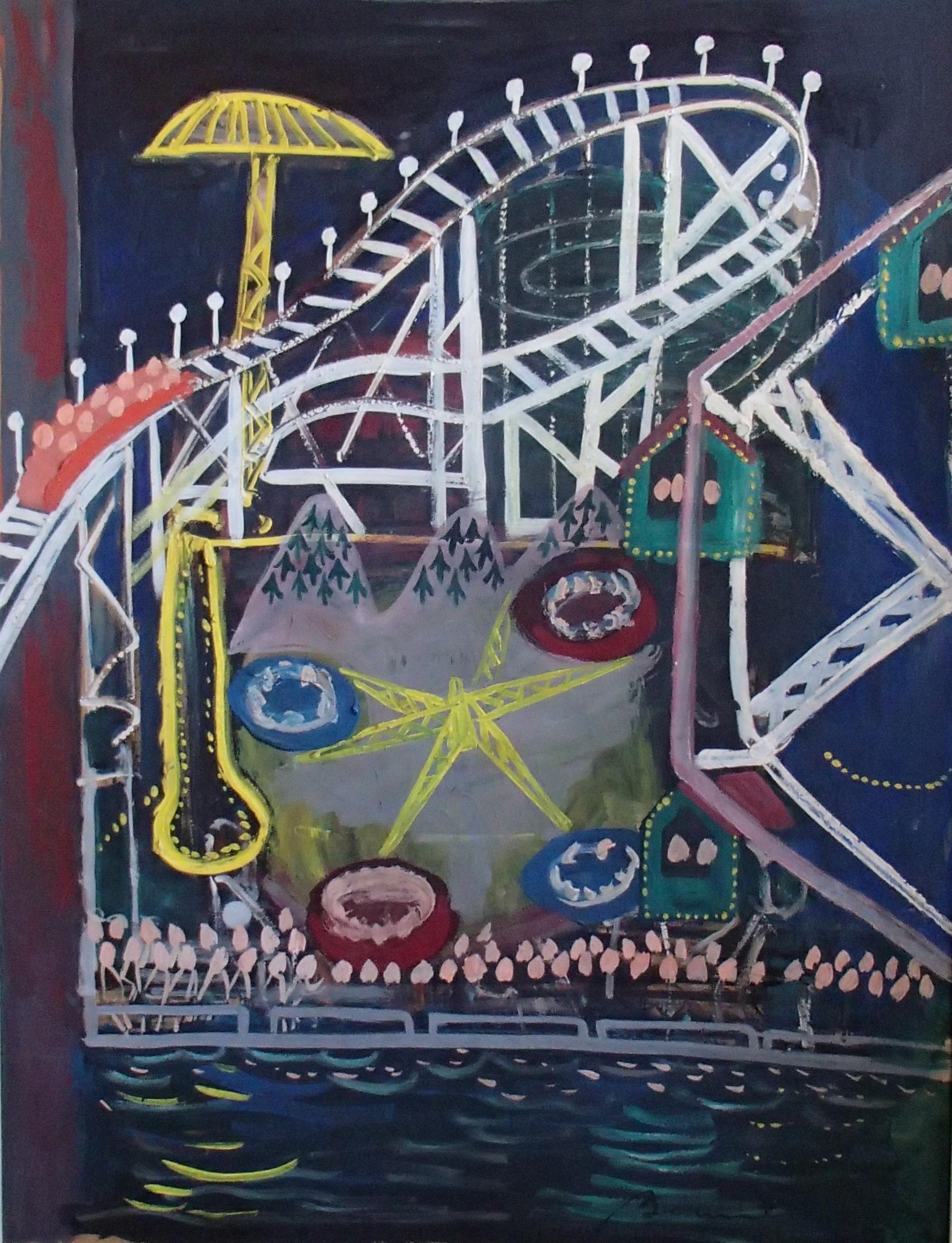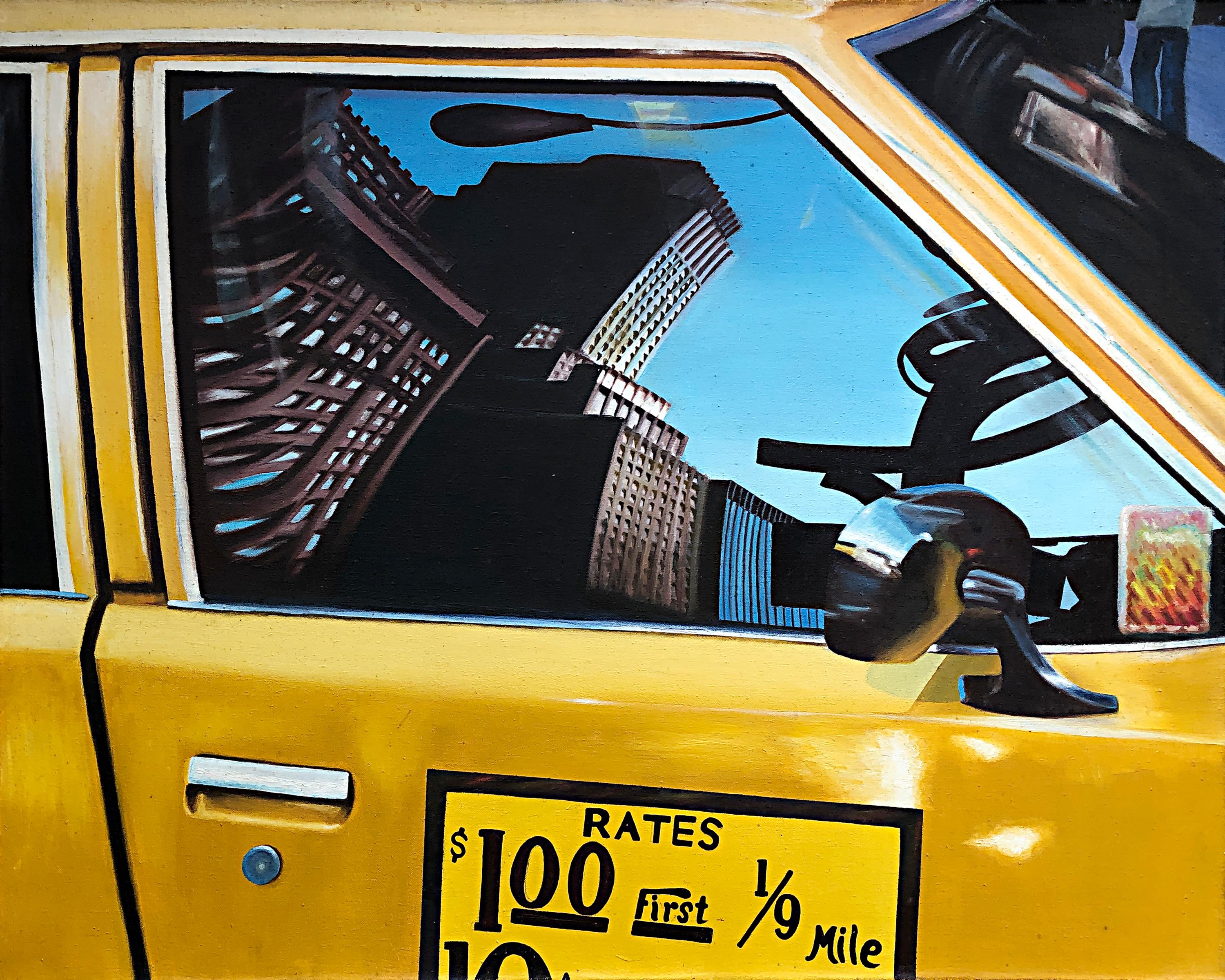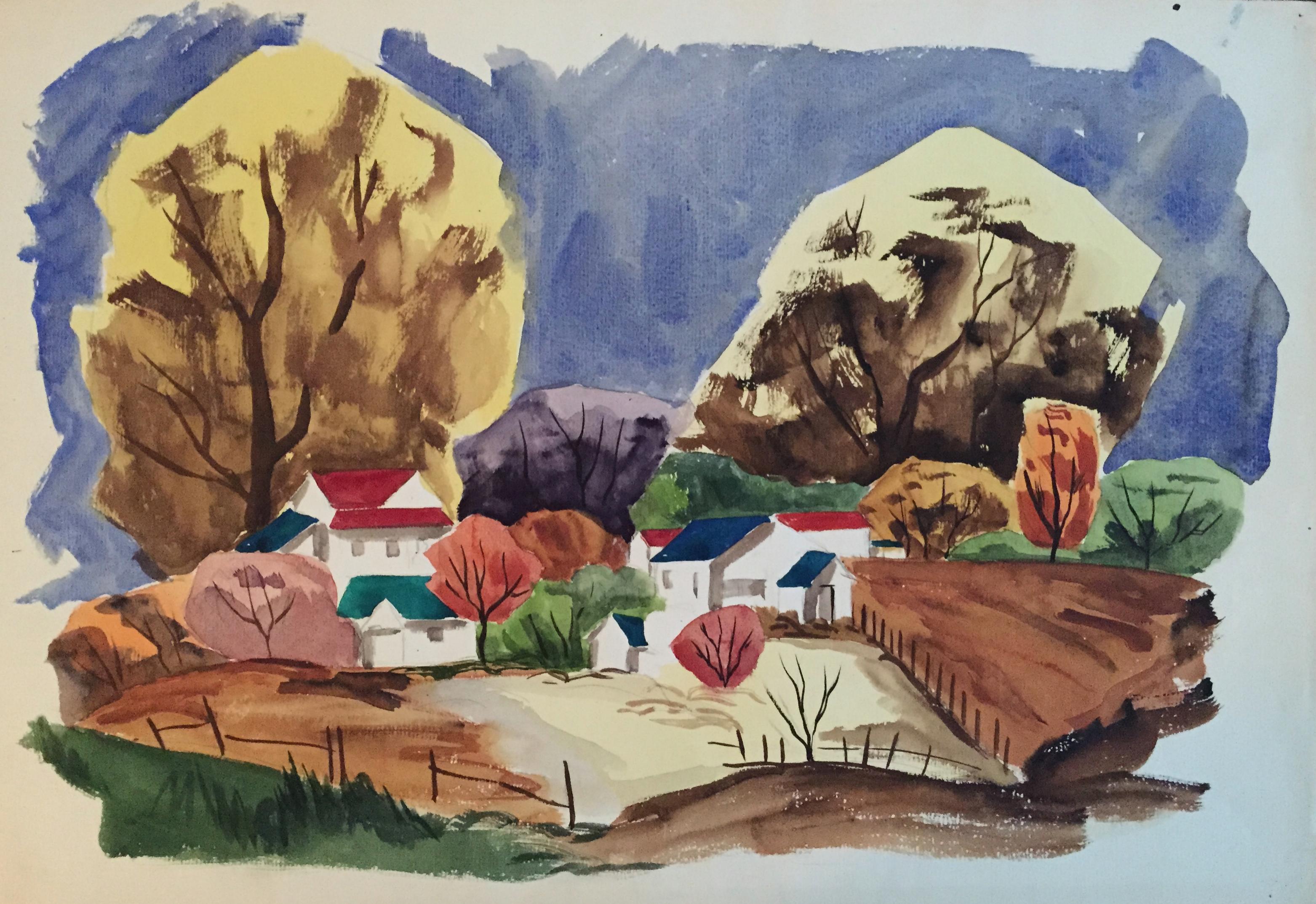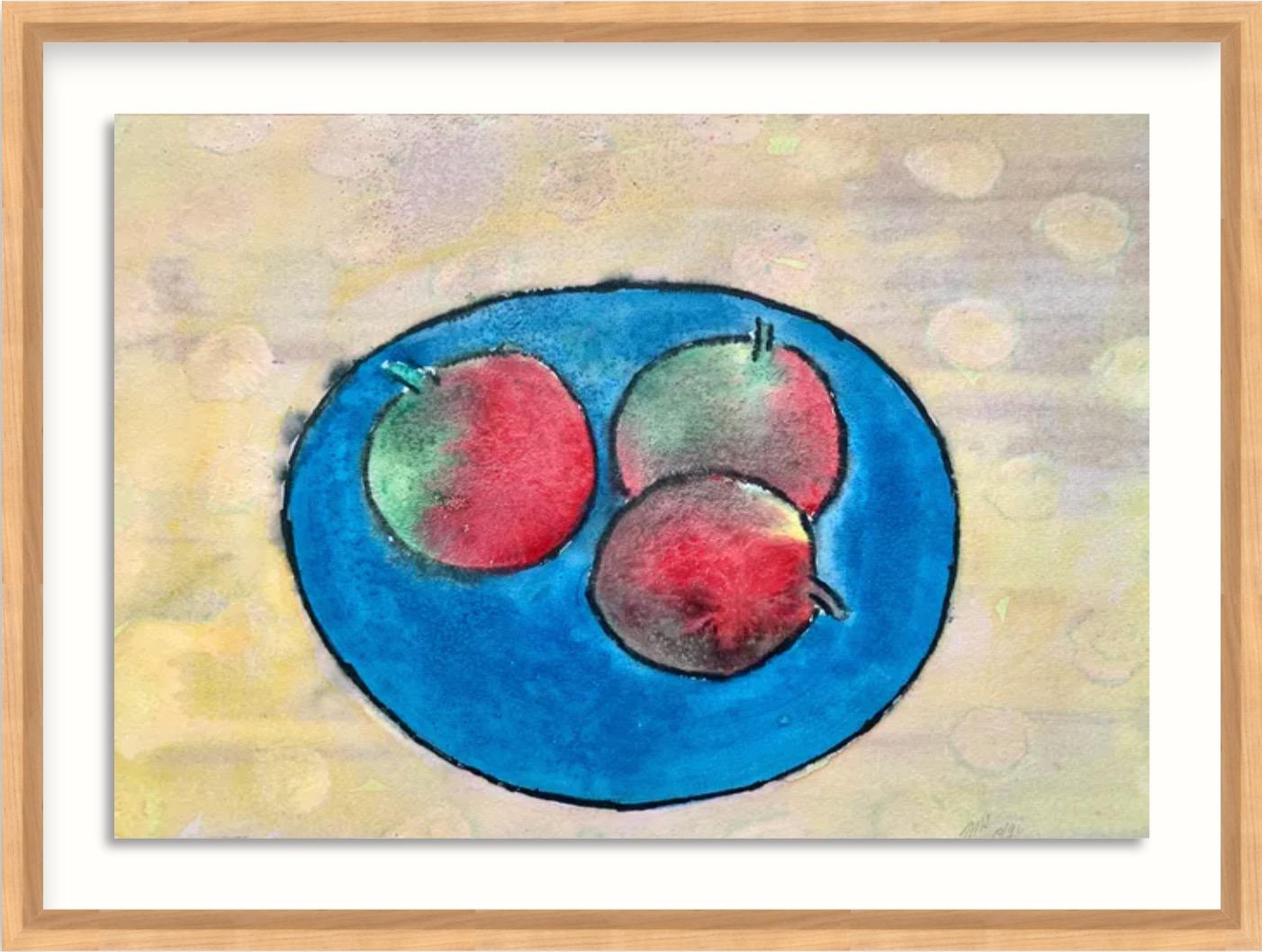Items Similar to WPA Landscape American Scene Social Realism Mid 20th Century Modern Farm Rural
Want more images or videos?
Request additional images or videos from the seller
1 of 7
James McCrackenWPA Landscape American Scene Social Realism Mid 20th Century Modern Farm Rural1930s
1930s
About the Item
WPA Landscape American Scene Social Realism Mid 20th Century Modern Farm Rural
James McCracken (1875 – 1967)
WPA Landscape
28 x 36 inches
Oil on canvas, c. 1930s
Signed lower right
BIO
James McCracken was born in Pundland, Scotland in 1875 and as a young man emigrated to the United States, there he settled in a suburb of Chicago, Oak Park.
As a successful painter and illustrator, he kept studios and exhibited in New York and Miami. It has been said of McCracken's work that it is, "highly stylized technique of flat, linear compositions and rich, pastel colors."
He is best known for his pastoral landscapes and tropical scenes. McCracken was a successful illustrator, contributing cover work to national magazines and illustrations for children's books, newspapers and railroad posters.
- Creator:James McCracken (1875 - 1967, American)
- Creation Year:1930s
- Dimensions:Height: 34 in (86.36 cm)Width: 42 in (106.68 cm)
- Medium:
- Movement & Style:
- Period:
- Condition:
- Gallery Location:New York, NY
- Reference Number:1stDibs: LU1156214152422
About the Seller
5.0
Platinum Seller
These expertly vetted sellers are 1stDibs' most experienced sellers and are rated highest by our customers.
Established in 2008
1stDibs seller since 2019
164 sales on 1stDibs
Typical response time: <1 hour
- ShippingRetrieving quote...Ships From: Pawling, NY
- Return PolicyA return for this item may be initiated within 3 days of delivery.
More From This SellerView All
- "Coney Island" Brooklyn NYC Amusement Park Mid-century American Scene WPA ModernBy Ludwig Bemelmans, 1898-1962Located in New York, NY"Coney Island" Brooklyn NYC Amusement Park Mid-century American Scene WPA Modern Ludwig Bemelmans (1898 – 1962), “Coney Island" 35 x 27 inches Oil on board Signed lower left Origin...Category
1940s American Modern Landscape Paintings
MaterialsOil, Board
- "Time Remembered" Mid 20th Century NYC Modern American Scene WPA El Railway 1940Located in New York, NY"Time Remembered" Mid 20th Century NYC Modern American Scene WPA El Railway 1940 A view of the Third Avenue El (elevated railway) at 28th Street, New York. Signed lower left. Titled verso. c. 1940. oil on board c. 1940, 27.875 h × 21.75 w inches. BIO Staats Cotsworth...Category
1940s American Realist Landscape Paintings
MaterialsOil, Board
- 1, 000 piece Museum Quality Collection of Art & Objects from NYC 1939 Worlds FairBy Harry LaneLocated in New York, NY1,000 piece Museum Quality Collection of Art & Objects from NYC 1939 Worlds Fair Harry Lane (1891-1973) "1939 World’s Fair Construction," 30 x 40 inches, Oil on canvas, signed lower...Category
1930s American Modern Landscape Paintings
MaterialsPlaster, Photographic Paper, Canvas, Oil
- NYC Cityscape American Scene WPA Modern Realism Mid 20th Century ArchitecturalBy Ernest FieneLocated in New York, NYNYC Cityscape American Scene WPA Modern Realism Mid 20th Century Architectural Ernest Fiene (1894-1965) Cityscape 36 x 30 inches Oil on canvas Signed and dated 1930. lower right Provenance Estate of the artist. ACA Galleries, New York Exhibited New York, Frank Rehn Gallery, Changing Old New York, 1931. New York, ACA Galleries, Ernest Fiene: Art of the City, 1925-1955, May 2-23, 1981, n.p., no. 5. BIO Ernest Fiene was born in Elberfeld, Germany in 1894. As a teenager, Fiene immigrated to the United States in 1912. He studied art at the National Academy of Design in New York City from 1914 to 1918, taking day classes with Thomas Maynard and evening classes with Leon Kroll. Fiene continued his studies at the Beaux-Arts Institute of Design in New York from 1916 to 1918, adding classes in printmaking at the Art Students League in 1923. Fiene began his career as an artist in 1919 with his first exhibition of watercolors at the MacDowell Club arranged by his mentor Robert Henri. In 1923 the Whitney Studio Club mounted a large exhibition of his works. The following year he had an exhibition at the New Gallery in New York, which completely sold out all fifty-two works, including paintings, watercolors, drawings, and etchings. With the proceeds of sales from the New Gallery exhibition, Ernest Fiene and his younger brother Paul, a sculptor, built studios in Woodstock, New York in 1925. In the early Twenties Ernest Fiene painted mostly landscapes of Woodstock and both the Ramapo and Hudson River Valleys. The first monograph from the Younger Artists Series was published on Fiene in 1922. Published in Woodstock, the series went on to include Alexander Brook, Peggy Bacon, and Yasuo Kuniyoshi. The book reproduced 1 illustration in color and another 27 reproductions in black and white. Around 1925 Fiene became fascinated with the intensity, excitement, and opportunities for color harmonies New York City offered as a subject. His paintings shifted to urban and industrial themes with architecture, industry, and transportation becoming his subjects. By 1926 Fiene had attracted the dealer Frank K.M. Rehn, who gave him a one-man exhibition that year, which travelled to the Boston Arts Club. C.W. Kraushaar Galleries gave Fiene a one-man exhibition of urban, landscape, portrait, and still life paintings in 1927. Julianna Force, the director of the Whitney Studio Club and first director of the Whitney Museum of American Art, included two of Fiene’s paintings in a fall exhibition in 1928. The Whitney Studio Club showed Fiene’s paintings in a two-man exhibition with Glenn O. Coleman that year and acquired three of Fiene’s paintings. Also in 1928 Fiene became affiliated with Edith Halpert’s Downtown Gallery where he had an exhibition of 20 lithographs in the spring. Fiene sold his house in Woodstock in 1928 to spend more of his time in New York City. With so many successful exhibitions, Fiene returned to Paris in 1928-29 where he rented Jules Pascin's studio and studied at the Académie de la Grande Chaumière. In France, Fiene painted both landscape and urban subjects developed from ideas influenced by Cubist geometry and the use of flat areas of broad color. Upon returning to New York in 1930, Fiene used this new approach to continue to paint New York skyscraper and waterfront subjects, as well as to begin a series of paintings on changing old New York based on the excavations for Radio City Music Hall and the construction of the Empire State Building. Frank K.M. Rehn Galleries exhibited this series, titled “Changing Old New York,” in 1931. Fiene also has solo exhibitions at Rehn Galleries in 1930 and 1932. Fiene’s oil paintings are exhibited at the Chicago Arts Club in 1930 as well. Fiene was included in the Museum of Modern Art’s exhibition Painting and Sculpture by Living Americans in December of 1931. Visiting New York, Henri Matisse saw the exhibition and called Fiene’s Razing Buildings, West 49th Street the finest painting he had seen in New York. Fiene had two mural studies from his Mechanical Progress series exhibited at the Museum of Modern Art’s exhibition Murals by American Painters and Photographers in 1932. Fiene sent View from my Window which depicts Fiene working on a lithograph stone while looking out his window to the newly completed Empire State Building to the Carnegie International in 1931. In 1932 Fiene participated in the first Biennial of American Painting at the Whitney Museum and his prints were included in exhibitions at the Downtown Gallery and the Wehye Gallery. In the same year, Fiene was awarded a Guggenheim fellowship to further study mural painting in Florence, Italy. On his return from Italy in 1933 Fiene re-engaged himself in New York City life and won several public and private mural projects. Fiene resumed his active exhibition schedule, participating in two group exhibitions at the Whitney Museum and a one-man exhibition of recent paintings at the Downtown Gallery in January 1934. In 1933 he purchased a farm in Southbury, Connecticut, which added Connecticut scenes to his landscape subjects. This was also the year Fiene began to spend summers on Monhegan Island, Maine, where he painted seascapes, harbor scenes, and still lifes. Fiene’s landscape paintings attracted numerous commissions as part of the American Scene movement. Through the fall and winter of 1935-36, Fiene took an extended sketching trip through the urban, industrial, and farming areas of Pennsylvania and West Virginia. Most of the twenty-four Pennsylvania urban and rural paintings...Category
1930s American Modern Landscape Paintings
MaterialsCanvas, Oil
- "Concert" Early 20th Century WPA Modernism American City Landscape Scene AshcanBy Michael LoewLocated in New York, NY"Concert" Early 20th Century WPA Modernism American City Landscape Scene Ashcan The size of the canvas 28 3/4 x 43 1/4 inches. The painting comes directly from the artist's estate. It is signed lower right as well as signed, titled and dated verso. We have available more than two dozen paintings and works on paper from the 1930s - 80s that come directly from the Loew estate. BIO Michael Loew (1907 – 1985) was the son of a New York City baker. After high school, he was an apprentice to a stained-glass maker, and from 1926-1929, he studied at the Art Students League. In 1929, he traveled to Paris, North Africa, Germany, and Italy with a group of artists. When he returned to New York City in 1931, the Great Depression hit Loew unexpectedly, and for the next two years he paid his apartment rent with his paintings. In 1935, he found work with the WPA where he painted murals and partnered up with longtime friend Willem de Kooning in 1939 on a mural for the Hall of Pharmacy at the New York World’s Fair. Their friendship lasted for the rest of their lives. In the mid-30’s he painted in Mexico and the Yucatán documenting the construction of a U.S. Naval airbase on Tinian Island. It was from this airbase that the Enola...Category
1920s American Modern Figurative Paintings
MaterialsCanvas, Oil
- NYC 1939 World's Fair Mural Study American Scene WPA Modern Mid 20th CenturyLocated in New York, NYNYC 1939 World's Fair Mural Study American Scene WPA Modern Mid 20th Century Eugene Savage (1883 – 1978) 1939 World’s Fair Mural Study 45 x 30 inches Oil on Canvas Signed lower right The painting is part of a 1,000 piece collection of art and objects from the 1939 World’s Fair. The collection as a whole is available. Savage created the mural for the facade of the Communications Building. An image of the completed mural, along with a published postcard, is part of the listing. Note the center top female figure, she resembles the figure in the offered painting. BIO Eugene Francis Savage was born in Covington, Indiana 1883. He underwent various forms of art training in the early years. He was a pupil of The Corcoran Gallery and The Art Institute of Chicago, and was later awarded a fellowship to study in Rome at The American Academy. While under the spell of that ancient city the young artist began to render historic figures that were suitable for the classic style needed for mural painting in the traditional manor. During this period he was able to study and observe Roman and Greek sculpture, although much of the academic training was accomplished by using plaster casts along with the incorporation of live models. This method survived and was used efficiently throughout Europe and the United States. After leaving the Academy, Savage was commissioned to paint numerous murals throughout the United States and Europe. This artist received acclaim for the works he produced while under commissions from various sources. This young master was a contemporary of Mexican muralists David Alfaro Siqueiros (1896-1974), Jose Clemente Orozco (1883-1949) and Diego Rivera (1886-1957). In this period he was to show the influence of his contemporaries in formulating a modern style. Savage also played a vital role in the WPA Federal Art program, and he was a member of The Mural Art Guild.. Savage was elected an associate member of The National Academy of Design in 1924 and a full member in 1926. From 1947, he held a professorship at Yale University where he taught mural painting, and some of his students went on to significant positions. By this time the artist had painted large-scale murals at Columbia, Yale University, Buffalo N.Y., Dallas, Texas, Chicago, Indiana, along with other commissioned works. He also achieved recognition for a series of murals commissioned by the Matson Shipping Line and completed around 1940. For this commission, Savage made many exacting studies of customs and folkways of the Hawaiian natives. However, the award-winning murals were not installed as planned but were put in storage during the war years when the ships were used for troop transportation and were in danger of attack. However the mural images were reproduced and distributed by the shipping company including nine of the mural scenes that were made into lithographed menu covers in 1948. The American Institute of Graphic Arts awarded certificates of excellence for their graphic production, and the Smithsonian Institute exhibited the works in 1949. Today Savages' Hawaiian Art production is held in high regard by collectors of Hawaiian nostalgia. In later years the artist focused his attention on a theme that dealt with the customs and tribal traditions of the Seminole Indians of Florida. He produced many variations of this theme throughout his lifetime, and the pictures were usually modest scale easel paintings, precise and carefully delineated. Many of these pictures incorporate Surrealistic elements and show some minor stylistic influences of the painters Kay Sage...Category
1930s American Modern Figurative Paintings
MaterialsCanvas, Oil
You May Also Like
- Large Landscape Scene Bay Area Artist "Two Ships Passing"Located in Arp, TXTrung Quoc Tran 1980's "Ships Passing" Oil on Canvas 35.5" x 47.5" unframed $1900 No Signature *Listed price reflects custom framing selected by seller. Please expect framing time be...Category
Late 20th Century American Modern Landscape Paintings
MaterialsCanvas, Oil
- Wild Flowers Vibrant Colorful Modernist Oil PaintingBy John WengerLocated in Surfside, FLJohn Wenger (1887-1976) celebrated easel painter and stage set designer whose career included 25 solo shows in the USA, Canada, and Europe. He created set designs for such plays as "Ile", "Petrushka", "Funny Face", and Rhapsody In Blue". John Wenger's art is included in many museums in and out of the USA. John Wenger was born on June 16, 1887 in Elizabethgrad, Russia. Wenger was born an artist, and at the age of three was painting (playing) with brushes and paint while his father, a local artist who painted scenery for the traveling theater, worked on drop scenes. His mother disapproved of this and tried to keep her son from playing with these "toys." When John Wenger was several years older, he attended Gihnazia, which is equivalent to high school but on a college level. Throughout his education Wenger excelled in visual arts. The staff at the Gihnazia school encouraged him to apply to the Imperial Art Academy of Odessa for a scholarship. At the age of thirteen, John Wenger became a student at the academy. For Wenger, this was his first time away from home and he found it to be difficult for several months. When he came to America in 1903, John earned his living by designing ladies costumes and jewelry at his uncles store in Newark, New Jersey. He then resumed his art studies at Cooper Union and The National Academy of Design. While in New York, Wenger found an interest in how music and theater connected to art. He rebelled against the heavy sets and hard lines of stage scenery...Category
Mid-20th Century American Modern Still-life Paintings
MaterialsOil
- Yellow Cab Madison Square GardenLocated in West Palm Beach, FLKhawam’s first genre of paintings started in 1980 during the heights of the Superrealism movement in New York City where Khawam was the youngest among the group and in his first year...Category
1980s American Modern Landscape Paintings
MaterialsAcrylic
- Mid Century California Landscape Painting "Colored Roofs" Gouache on PaperLocated in Arp, TXThelma Corbin Moody (1908-1986) Colored Roofs c. 1960s Gouache on Watercolor Paper 22" x 15", Unframed This piece is unsigned and came from a large...Category
Mid-20th Century American Modern Landscape Paintings
MaterialsPaper, Gouache
- American Modernist Jack Hooper "Fruit Still Life" Original PaintingBy Jack HooperLocated in Arp, TXJack Hooper "Fruit Still Life" 10-1996 Conte crayon and gouache on paper 19.75"x14.25" cherry wood frame with white sides 24.25"x18.25" Signed and dated in...Category
1990s American Modern Landscape Paintings
MaterialsPaper, Conté, Gouache
- American Modern Artist Jack Hooper "Trees and Bulls" Abstract Landscape PaintingBy Jack HooperLocated in Arp, TXJack Hooper "Trees and Bulls" - Mexico 1-12-1993 Acrylic and conte crayon on rag paper 30.75"x21.25" unframed Signed and dated in pencil lower right *Custo...Category
1990s American Modern Landscape Paintings
MaterialsPaper, Conté, Acrylic




